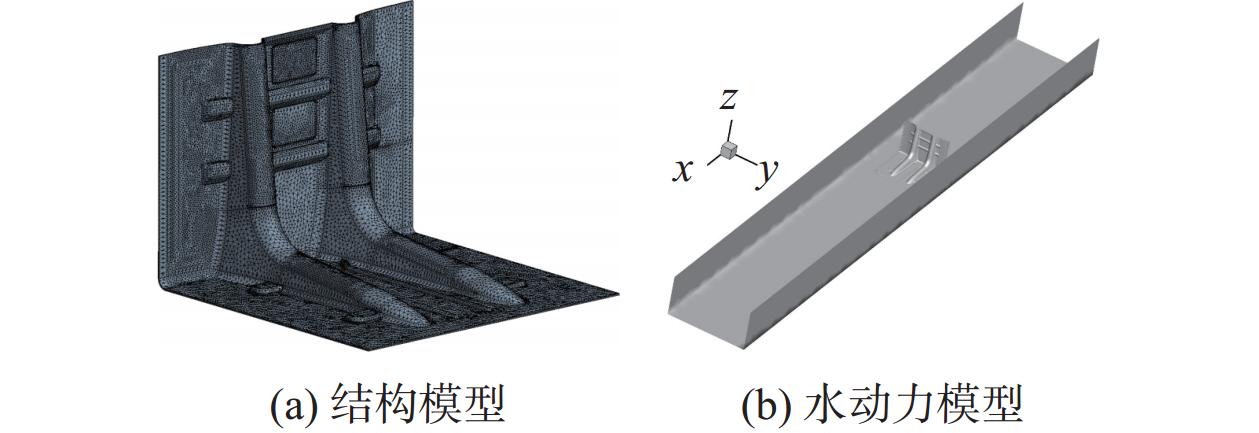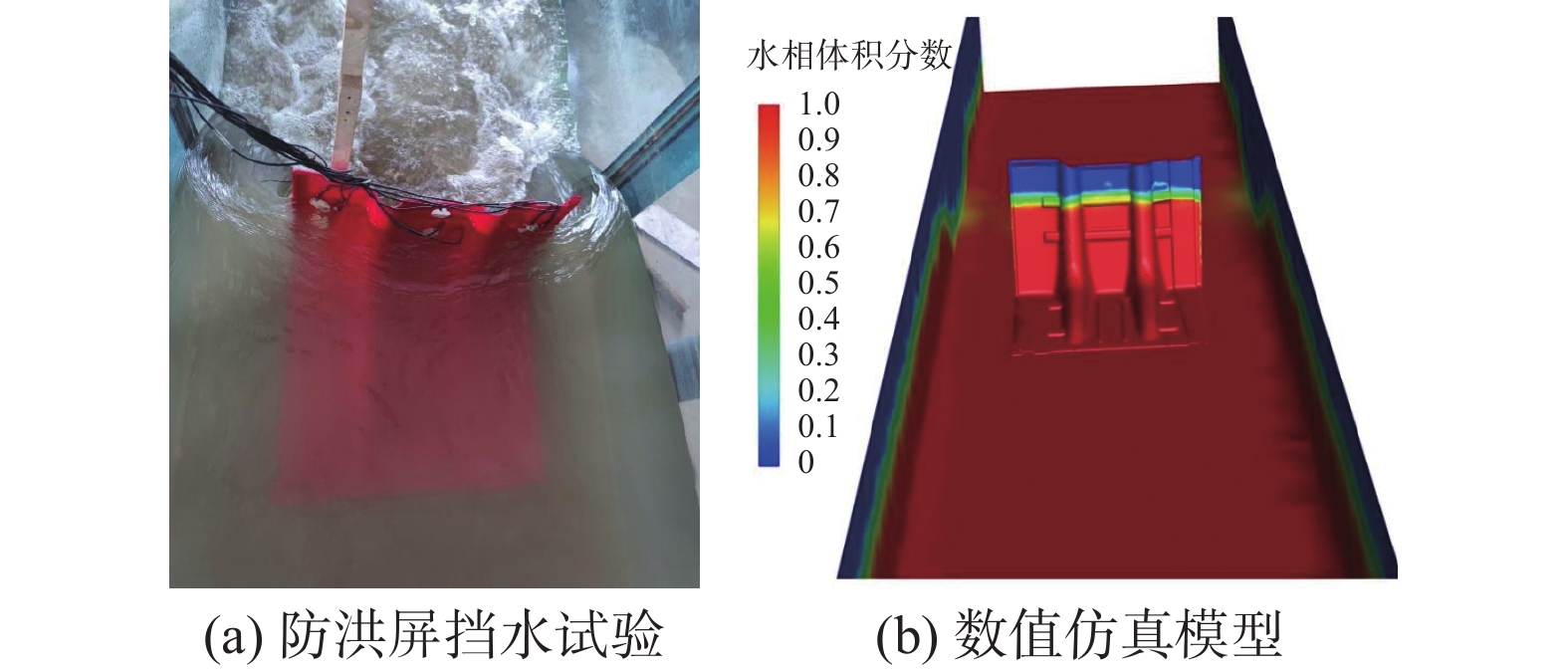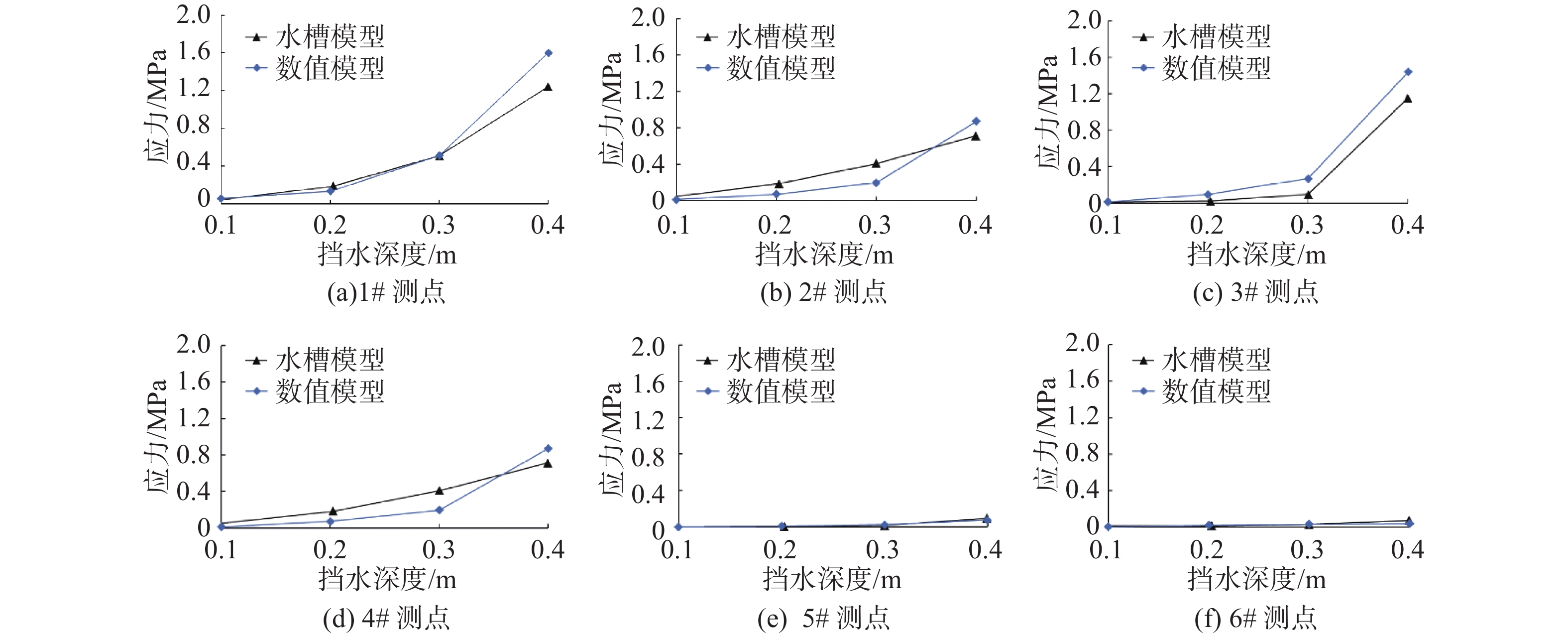Analysis of the stress on L-shaped urban emergency flood control screens based on polymer materials
-
摘要:
国内关于高分子材质城市内涝应急防御装备的研究较为少见。采用水槽试验与流固耦合数值仿真相结合的方法,对城市应急防洪屏(以下简称“防洪屏”)的结构受力特性展开研究。结果表明,数值仿真模拟与试验结果吻合较好。随着水深和流速的增大,防洪屏的应力和变形逐渐增大,最大应力位于防洪屏的踵部,最大变形位于挡水面顶部两侧。防洪屏的结构受力系数随着来流弗劳德数的增大快速衰减,当弗劳德数大于0.15后,结构受力系数趋于定值;相对于惯性力,防洪屏承受最大应力的影响因素主要是重力。研究结果可为防洪屏的进一步优化设计提供参考。
Abstract:Research on polymer-based urban emergency flood control equipment is relatively rare in China. In this study, a combination of water tank experiments and fluid-structure interaction numerical simulations was used to investigate the stress characteristics of urban emergency flood control screens (referred to as “flood control screens” hereafter). The results show good agreement between the numerical simulation and experimental results. As the water depth and flow velocity increase, the stress and deformation of the flood control screens gradually increase. The maximum stress is located at the heel of the flood control screens, while the maximum deformation is observed at the top sides of the water-blocking surface. The stress coefficient of the flood control screens decreases rapidly with the increase of the incoming flow Froude number, and it tends to a constant value when the Froude number exceeds 0.15. Gravity has a greater influence on the maximum stress of the flood control screens compared to inertial forces. The findings of this study can provide a reference for the further optimization design of flood control screens.
-
近年来,随着中国城市化进程的不断推进,城市热岛及雨岛效应凸显,短历时强降雨导致的城市洪涝灾害多发频发,“城市看海”现象连年发生,城市洪涝灾害的问题日趋严重[1-2]。统计显示,中国约三分之二以上的城市发生过不同程度的暴雨洪涝灾害,严重威胁人民生命财产安全和社会稳定。如2021年郑州“7·20”特大暴雨,最大小时雨量达201.9 mm,最大日降雨量为624.1 mm [3];2019年4月深圳发生了短时极端强降水天气;2012年北京“7·21”特大暴雨,最大日降雨量为460 mm,最大小时雨量为100.3 mm,造成了巨大的经济损失 [4-6]。应对城市暴雨链生洪涝灾害,暴露出中国城市防灾减灾治理的不足和城市内涝应急抢险装备的短板。因此,强化灾中应急处置与救援装备建设,对提高城市的整体防灾减灾韧性具有至关重要的作用[7]。
目前,针对新型防洪抢险装备,国内外学者开展了一些探索和研究。徐超炎等[8]对比了景观堆坡塑型、装配式闸板组合防汛墙、通透式玻璃防洪墙等多种结构,提出城市防洪除追求防洪能力外,还应与城市应用场景相适应;丁泽霖等[9]等采用有限单元法,对移动式防洪墙的结构受力特性进行了研究,并基于响应面法对体型参数等进行优化分析,为移动防洪墙的设计和结构优化提供了参考;Su等[10]采用有限元法对移动式防洪墙各个配件在挡水过程中的受力特性进行分析,得到了防洪墙各部件的最大应力及其所在位置,为其结构优化提供了参考;Wang等[11]探究了一种四面均为双曲型的“动能伞”结构,应用于近海涌浪的防御,并采用有限元方法对“动能伞”挡水面的体型、材料和支撑结构的受力特性等进行研究,得到了该结构的最佳厚度和体型尺寸,并对其材质进行了探讨。
功能性高分子材质的城市内涝应急抢险装备具有绿色环保、安全高效及可重复使用等显著优点,能较好地适应城市内涝动态新型风险的挑战,在实践中已有应用,但目前国内外针对其结构受力特性的相关研究还较为少见[12],其设计和应用还缺乏相关的理论支撑。本文采用水槽试验与流固耦合数值仿真相结合的方法,针对城市应急防洪屏的结构受力特性开展研究,为后续进一步优化设计提供参考。
1. 研究方法
1.1 水槽试验
试验在多功能玻璃水槽内开展,水槽尺寸为10 m×1.2 m(长×宽),采用阀门控制上游水位和流量,下游为自由出流边界。试验前对防洪屏的材料性能及稳定性进行了初步分析[13],常见高分子材质中,ABS材料的力学性能较优,其结构受力在一定范围内符合弹性材料特性。因此,本文选取ABS材质防洪屏(L(长)×B(宽)×H(高)为664 mm×692 mm×500 mm)进行挡水试验。
防洪屏置于水槽正中间,左、右两侧距离水槽壁面各25.4 cm。在防洪屏挡水面设置9个应变片(图1),监测挡水过程中各测点的受力特性。试验过程中,通过水位标尺控制上游水位,采用电磁流量计记录上游流量,下游采用自由出流方式,采用悬桨流速仪测量防洪屏正前方距离挡水面1 m处的流速。
1.2 流固耦合数值仿真模型
基于Ansys软件,对不同挡水高度下防洪屏的应力、变形等特性进行研究[14]。首先采用Ansys Fluent软件中的水动力模型计算不同挡水高度下防洪屏承受的压力,再结合Ansys Mechanical软件计算该压力下防洪屏挡水过程中的应力、变形特性。计算包括结构动力学模型和流体动力学模型两部分。
1.2.1 结构动力学模型
假定防洪屏在挡水过程中符合弹性材质的特点,则可采用下式来描述其受力特性:
$$ Ms'' + Cs' + Ks = F(t) $$ (1) 式中:M为质量矩阵;C为阻尼矩阵;K为刚度矩阵;$s''$、$s'$和$s$分别为加速度矢量、速度矢量和位移矢量,F(t)为力矢量。假定物理量都不随时间而变化,可得到线性静力方程为:
$$ F = Ks $$ (2) 式(2)表明,静力荷载值与时间和惯性无关。结构动力学模型见图2(a)。结构力学分析中,将流体动力学模型计算所得的静、动水压力作为边界条件进行结构应力和变形计算。
1.2.2 流体动力学模型
流体动力学模型中,质量守恒方程和不可压缩流体的动量方程如下:
$$ \frac{\partial \rho}{\partial t}+\frac{\partial(\rho u)}{\partial x}+\frac{\partial(\rho v)}{\partial y}+\frac{\partial(\rho w)}{\partial {\textit{z}}}=0 $$ (3) $$ \frac{\partial u}{\partial t}+u \frac{\partial u}{\partial x}+v \frac{\partial u}{\partial y}+w \frac{\partial u}{\partial {\textit{z}}}=F_x-\frac{1}{\rho} \frac{\partial p}{\partial x}+v\left(\frac{\partial^2 u}{\partial x^2}+\frac{\partial^2 u}{\partial y^2}+\frac{\partial^2 u}{\partial {\textit{z}}^2}\right)$$ (4) $$ \frac{\partial v}{\partial t}+u \frac{\partial v}{\partial x}+v \frac{\partial v}{\partial y}+w \frac{\partial v}{\partial {\textit{z}}}=F_{y}-\frac{1}{\rho} \frac{\partial p}{\partial y}+v\left(\frac{\partial^{2} v}{\partial x^{2}}+\frac{\partial^{2} v}{\partial y^{2}}+\frac{\partial^{2} v}{\partial {\textit{z}}^{2}}\right) $$ (5) $$ \frac{\partial w}{\partial t}+u \frac{\partial w}{\partial x}+v \frac{\partial w}{\partial y}+w \frac{\partial w}{\partial {\textit{z}}}=F_{{\textit{z}}}-\frac{1}{\rho} \frac{\partial p}{\partial {\textit{z}}}+v\left(\frac{\partial^{2} w}{\partial x^{2}}+\frac{\partial^{2} w}{\partial y^{2}}+\frac{\partial^{2} w}{\partial {\textit{z}}^{2}}\right) $$ (6) 式中:ρ为流体密度(kg/m3);t为时间(s);u、v、w为速度矢量在x、y、z方向上的分量;Fx、Fy和Fz为流体单元所受的力在x、y、z方向上的分量;ν为运动黏性系数(m2/s)。
结合研究的实际情况,采用k-ε模型来计算挡水过程中湍流特性。采用PISO算法的迭代方法进行数值计算。本研究采用VOF (Volume of Fluid)方法追踪自由液面。数值仿真模型体型与水槽试验体型保持一致(见图2(b)),流体计算网格数约224万个。
2. 结果分析
2.1 模型验证
水槽试验结果表明,不同水深和流速下,防洪屏均能保持稳定,水流由防洪屏的两侧泄入下游,防洪屏迎水面有轻微变形,见图3(a)。随着挡水高度的增加,各测点的应力逐渐增大,且底部测点的应力均大于上部测点,这表明防洪屏挡水面的底部易产生应力集中,见表1。同一挡水条件下,防洪屏中部所受的应力小于两侧。尽管1#~3#测点与7#~9#测点为对称布置,但因7#~9#测点所在位置的右侧为略凸起的拱型体型,大部分工况下,1#~3#测点测得的应力较对应位置的7#~9#测点的应力更大。
表 1 水槽试验各工况下防洪屏应力及变形Table 1. Stress and deformation of flood control screens under various water tank test conditions工况 水深 /m 流速 /(m/s) 应力/MPa 变形/cm 前方 两侧 1# 2# 3# 4# 5# 6# 7# 8# 9# S-1 0.10 0.25 0.66 0.059 0.053 0.036 0.011 0.002 0.002 0.011 0.002 0.003 0.04 S-2 0.20 0.35 0.73 0.136 0.093 0.086 0.072 0.010 0.020 0.093 0.044 0.024 0.03 S-3 0.30 0.44 0.92 0.513 0.288 0.235 0.196 0.025 0.030 0.269 0.093 0.055 1.62 S-4 0.40 0.57 1.08 1.600 0.780 0.910 0.870 0.076 0.037 1.440 1.440 0.530 1.99 水槽试验与数值模拟在典型测点、同一工况下的应力对比见图4。可见,二者在数值及变化趋势上吻合较好,说明数值仿真模型可用于防洪屏的受力分析研究。
2.2 结构特性分析
采用数值仿真模型对防洪屏在水深0.1、0.2、0.3和0.4 m,流速0.2、0.5、1.0、1.5和2.0 m/s等各组合下的应力和变形进行计算,结果见表2。各工况下,水流在防洪屏前方形成一定的壅高,绕过防洪屏流向下游。初始水深0.4 m、初始流速1.5和2.0 m/s,以及初始水深0.3 m、初始流速2.0 m/s条件下,防洪屏前端水面壅高超过防洪屏高度,其应力和变形未计入表2。
表 2 流固耦合数值仿真模型各工况应力及变形Table 2. Stress and deformation of numerical simulation model under various fluid-structure interaction conditions初始条件 挡水高度及流速 最大应力/MPa 最大变形/mm Fr L/h (0.5+Fr2)/μ Cd 水深/m 流速/(m/s) 水深/m 流速/(m/s) 0.1 2.0 0.30 0.67 4.30 9.35 0.39 2.21 1.30 9 674.10 1.5 0.25 0.60 2.17 3.92 0.38 2.63 1.29 6 135.90 1.0 0.20 0.50 0.82 1.20 0.36 3.32 1.25 3 285.24 0.5 0.15 0.33 0.16 0.17 0.27 4.43 1.15 1 423.35 0.2 0.12 0.17 0.14 0.14 0.15 5.53 1.05 4 996.08 0.2 2.0 0.49 0.82 14.70 47.38 0.37 1.36 1.28 22 062.19 1.5 0.42 0.71 8.20 21.41 0.35 1.58 1.25 16 072.98 1.0 0.33 0.61 4.28 9.30 0.34 2.02 1.23 11 592.07 0.5 0.25 0.41 1.86 3.42 0.26 2.70 1.14 11 269.29 0.2 0.22 0.18 0.39 0.69 0.12 3.03 1.03 11 664.71 0.3 1.5 0.42 1.06 13.75 27.11 0.52 1.57 1.55 12 149.50 1.0 0.37 0.80 8.87 17.80 0.42 1.78 1.35 13 716.57 0.5 0.32 0.47 7.14 14.27 0.27 2.09 1.14 32 092.26 0.2 0.31 0.19 5.07 8.40 0.11 2.14 1.02 135 450.28 0.4 1.0 0.50 0.81 11.49 34.63 0.37 1.34 1.27 17 673.17 0.5 0.45 0.44 10.33 30.00 0.21 1.48 1.09 52 295.63 0.2 0.41 0.19 9.83 27.95 0.10 1.60 1.02 263 199.98 由表2可见,水流冲击作用下防洪屏的最大应力为14.70 MPa,小于防洪屏材料的屈服强度32.8 MPa[15]。挡水过程中,最大应力发生在防洪屏的踵部两侧边缘,所以该处较易发生破坏。变形小于47.38 mm,整体变形相对较小,最大变形发生在防洪屏迎水面的顶端两侧。
防洪屏在挡水过程中,易在水流的作用下发生滑动和倾覆。徐进超等[12]的研究表明,为保证防洪屏的防滑稳定,防洪屏的长高比与来流弗劳德数需满足一定的关系:
$$ L/h \geqslant\left( {0.5 + F{r^{\text{2}}}} \right)/{\mu } $$ (7) 式中:L为防洪屏长度(m);各工况下,h为挡水高度(m);μ为材料的摩擦系数。计算所得防洪屏的来流弗劳德数可表示为:
$$ Fr=\frac{V}{\sqrt{gh}} $$ (8) 式中:V为来流平均流速(m/s)。选取距防洪屏上游1 m,水流相对稳定区域的流速和水深计算Fr见表2。结果表明,各工况下的Fr为0.10~0.52,计算所得的长高比均大于同工况下的$ \left(0.5+\mathit{{F}{r}}^{\text{2}}\right)/\mu $值(假定μ=0.5)。
同时,为研究结构应力与动水压力的影响,采用结构受力系数Cd[16]对结构应力进行无量纲分析,Cd可表示为:
$$ {C_{\text{d}}} = \frac{\sigma }{{\rho {V^2}}} $$ (9) 式中:应力σ采用计算所得防洪屏上的应力(Pa)。选取防洪屏在挡水过程中出现的最大应力σmax进行结构受力系数分析(表2)。分析弗劳德数Fr与结构受力系数Cd的关系可知:在研究范围内,在Fr较小的惯性力主导阶段,Cd的值较大;随着Fr的增大Cd迅速衰减,Fr>0.15后,Cd随Fr的变化较小(见图5)。这表明在挡水过程中,相对于惯性力,防洪屏承受的最大应力的影响因素主要是重力。
3. 结 语
本文采用水槽试验与流固耦合数值仿真模拟相结合的方法,对功能性高分子材质的城市应急防洪屏的结构力学特性进行了研究。结果表明:(1)随着水深和流速的增大,防洪屏的应力和变形也逐渐增大,其最大应力位于防洪屏的踵部,最大变形位于挡水面顶部两侧。所建的数值仿真模型与试验结果在应力和变形的大小和趋势上大致相同,数值模型精度较好。(2)防洪屏的结构受力系数随着来流弗劳德数的增大快速衰减,在弗劳德数大于0.15后,结构受力系数趋于定值。相对于惯性力,防洪屏承受最大应力的影响因素主要是重力。虽然本文的研究工况相对简单,但研究结果可为防洪屏的进一步优化设计提供参考。
-
表 1 水槽试验各工况下防洪屏应力及变形
Table 1 Stress and deformation of flood control screens under various water tank test conditions
工况 水深 /m 流速 /(m/s) 应力/MPa 变形/cm 前方 两侧 1# 2# 3# 4# 5# 6# 7# 8# 9# S-1 0.10 0.25 0.66 0.059 0.053 0.036 0.011 0.002 0.002 0.011 0.002 0.003 0.04 S-2 0.20 0.35 0.73 0.136 0.093 0.086 0.072 0.010 0.020 0.093 0.044 0.024 0.03 S-3 0.30 0.44 0.92 0.513 0.288 0.235 0.196 0.025 0.030 0.269 0.093 0.055 1.62 S-4 0.40 0.57 1.08 1.600 0.780 0.910 0.870 0.076 0.037 1.440 1.440 0.530 1.99 表 2 流固耦合数值仿真模型各工况应力及变形
Table 2 Stress and deformation of numerical simulation model under various fluid-structure interaction conditions
初始条件 挡水高度及流速 最大应力/MPa 最大变形/mm Fr L/h (0.5+Fr2)/μ Cd 水深/m 流速/(m/s) 水深/m 流速/(m/s) 0.1 2.0 0.30 0.67 4.30 9.35 0.39 2.21 1.30 9 674.10 1.5 0.25 0.60 2.17 3.92 0.38 2.63 1.29 6 135.90 1.0 0.20 0.50 0.82 1.20 0.36 3.32 1.25 3 285.24 0.5 0.15 0.33 0.16 0.17 0.27 4.43 1.15 1 423.35 0.2 0.12 0.17 0.14 0.14 0.15 5.53 1.05 4 996.08 0.2 2.0 0.49 0.82 14.70 47.38 0.37 1.36 1.28 22 062.19 1.5 0.42 0.71 8.20 21.41 0.35 1.58 1.25 16 072.98 1.0 0.33 0.61 4.28 9.30 0.34 2.02 1.23 11 592.07 0.5 0.25 0.41 1.86 3.42 0.26 2.70 1.14 11 269.29 0.2 0.22 0.18 0.39 0.69 0.12 3.03 1.03 11 664.71 0.3 1.5 0.42 1.06 13.75 27.11 0.52 1.57 1.55 12 149.50 1.0 0.37 0.80 8.87 17.80 0.42 1.78 1.35 13 716.57 0.5 0.32 0.47 7.14 14.27 0.27 2.09 1.14 32 092.26 0.2 0.31 0.19 5.07 8.40 0.11 2.14 1.02 135 450.28 0.4 1.0 0.50 0.81 11.49 34.63 0.37 1.34 1.27 17 673.17 0.5 0.45 0.44 10.33 30.00 0.21 1.48 1.09 52 295.63 0.2 0.41 0.19 9.83 27.95 0.10 1.60 1.02 263 199.98 -
[1] 陈文龙, 杨芳, 宋利祥, 等. 高密度城市暴雨 洪涝防御对策: 郑州 “7·20” 特大暴雨启示[J]. 中国水利,2021(15):18-20, 23. (CHEN Wenlong, YANG Fang, SONG Lixiang, et al. Countermeasures for rainstorm and flood prevention in high-density cities: the “7·20” heavy rain revelation in Zhengzhou[J]. China Water Resources, 2021(15): 18-20, 23. (in Chinese) doi: 10.3969/j.issn.1000-1123.2021.15.018 CHEN Wenlong, YANG Fang, SONG Lixiang, et al. Countermeasures for rainstorm and flood prevention in high-density cities: the “7·20” heavy rain revelation in Zhengzhou[J]. China Water Resources, 2021(15): 18-20, 23. (in Chinese) doi: 10.3969/j.issn.1000-1123.2021.15.018
[2] 王远坤, 王栋, 黄国如, 等. 城市洪涝灾情评估与风险管理初探[J]. 水利水运工程学报,2019(6):139-142. (WANG Yuankun, WANG Dong, HUANG Guoru, et al. Urban flood disaster assessment and risk management[J]. Hydro-Science and Engineering, 2019(6): 139-142. (in Chinese) doi: 10.12170/201906016 WANG Yuankun, WANG Dong, HUANG Guoru, et al. Urban flood disaster assessment and risk management[J]. Hydro-Science and Engineering, 2019(6): 139-142. (in Chinese) doi: 10.12170/201906016
[3] 刘媛媛, 郑敬伟, 刘洪伟, 等. 极端大暴雨对城市防洪的警示和思考[J]. 中国防汛抗旱,2021,31(9):21-24. (LIU Yuanyuan, ZHENG Jingwei, LIU Hongwei, et al. Warning and thoughts of extreme rainstorm on urban flood prevention[J]. China Flood & Drought Management, 2021, 31(9): 21-24. (in Chinese) LIU Yuanyuan, ZHENG Jingwei, LIU Hongwei, et al. Warning and thoughts of extreme rainstorm on urban flood prevention[J]. China Flood & Drought Management, 2021, 31(9): 21-24. (in Chinese)
[4] 柳杨, 范子武, 谢忱, 等. 城镇化背景下我国城市洪涝灾害演变特征[J]. 水利水运工程学报,2018(2):10-18. (LIU Yang, FAN Ziwu, XIE Chen, et al. Study on evolvement law of urban flood disasters in China under urbanization[J]. Hydro-Science and Engineering, 2018(2): 10-18. (in Chinese) LIU Yang, FAN Ziwu, XIE Chen, et al. Study on evolvement law of urban flood disasters in China under urbanization[J]. Hydro-Science and Engineering, 2018(2): 10-18. (in Chinese)
[5] 张楚汉, 王光谦, 李铁键. 变化环境下城市暴雨致灾防御对策与建议[J]. 中国科学院院刊,2022,37(8):1126-1131. (ZHANG Chuhan, WANG Guangqian, LI Tiejian. Prevention countermeasures and suggestions for urban rainstorm disasters under changing environment[J]. Bulletin of Chinese Academy of Sciences, 2022, 37(8): 1126-1131. (in Chinese) ZHANG Chuhan, WANG Guangqian, LI Tiejian. Prevention countermeasures and suggestions for urban rainstorm disasters under changing environment[J]. Bulletin of Chinese Academy of Sciences, 2022, 37(8): 1126-1131. (in Chinese)
[6] 宋晓猛, 张建云, 王国庆, 等. 变化环境下城市水文学的发展与挑战: II. 城市雨洪模拟与管理[J]. 水科学进展,2014,25(5):752-764. (SONG Xiaomeng, ZHANG Jianyun, WANG Guoqing, et al. Development and challenges of urban hydrology in a changing environment: II: urban stormwater modeling and management[J]. Advances in Water Science, 2014, 25(5): 752-764. (in Chinese) SONG Xiaomeng, ZHANG Jianyun, WANG Guoqing, et al. Development and challenges of urban hydrology in a changing environment: II: urban stormwater modeling and management[J]. Advances in Water Science, 2014, 25(5): 752-764. (in Chinese)
[7] 马鑫, 侯精明, 李丙尧. 城市极端暴雨涝情变化特征模拟分析: 以宁夏固原市为例[J]. 人民长江,2023,54(7):1-7. (MA Xin, HOU Jingming, LI Bingyao. Simulation on variation characteristics of urban extreme rainstorm and waterlogging: case of Guyuan City, Ningxia Autonomous Region[J]. Yangtze River, 2023, 54(7): 1-7. (in Chinese) MA Xin, HOU Jingming, LI Bingyao. Simulation on variation characteristics of urban extreme rainstorm and waterlogging: case of Guyuan City, Ningxia Autonomous Region[J]. Yangtze River, 2023, 54(7): 1-7. (in Chinese)
[8] 徐超炎, 曾崇勇, 丁易峰, 等. 新型防洪墙在山区河流上的应用[J]. 水运工程,2021(12):145-149. (XU Chaoyan, ZENG Chongyong, DING Yifeng, et al. Application of a new type of flood control wall in mountainous rivers[J]. Port & Waterway Engineering, 2021(12): 145-149. (in Chinese) XU Chaoyan, ZENG Chongyong, DING Yifeng, et al. Application of a new type of flood control wall in mountainous rivers[J]. Port & Waterway Engineering, 2021(12): 145-149. (in Chinese)
[9] 丁泽霖, 朱轩毅, 张宏洋, 等. 基于响应面法的移动式防洪墙优化分析[J]. 人民黄河,2021,43(11):69-75. (DING Zelin, ZHU Xuanyi, ZHANG Hongyang, et al. Optimization analysis of mobile flood control wall based on response surface method[J]. Yellow River, 2021, 43(11): 69-75. (in Chinese) DING Zelin, ZHU Xuanyi, ZHANG Hongyang, et al. Optimization analysis of mobile flood control wall based on response surface method[J]. Yellow River, 2021, 43(11): 69-75. (in Chinese)
[10] SU C, YUAN Z W. Research on design of extensible mobile flood control wall in underground[J]. Mathematical Problems in Engineering, 2022, 2022: 9173769.
[11] WANG S Z, GARLOCK M, DEIKE L, et al. Feasibility of kinetic umbrellas as deployable flood barriers during landfalling hurricanes[J]. Journal of Structural Engineering, 2022, 148(5): 04022047. doi: 10.1061/(ASCE)ST.1943-541X.0003295
[12] 徐进超, 王小东, 董家, 等. L型城市应急防洪屏挡水稳定性研究[J]. 江苏水利,2023(4):70-72. (XU Jinchao, WANG Xiaodong, DONG Jia, et al. Research on hydraulic stability characteristics of L-shaped urban emergency flood barrier[J]. Jiangsu Water Resources, 2023(4): 70-72. (in Chinese) doi: 10.3969/j.issn.1007-7839.2023.4.jssl202304019 XU Jinchao, WANG Xiaodong, DONG Jia, et al. Research on hydraulic stability characteristics of L-shaped urban emergency flood barrier[J]. Jiangsu Water Resources, 2023(4): 70-72. (in Chinese) doi: 10.3969/j.issn.1007-7839.2023.4.jssl202304019
[13] 王小东, 徐进超, 赵君, 等. 注水式城市应急防洪箱结构优化研究[J]. 水电能源科学,2023(12):134-136, 146. (WANG Xiaodong, XU Jinchao, ZHAO Jun, et al. Structure optimization of urban emergency flood control box[J]. Water Resources and Power, 2023(12): 134-136, 146. (in Chinese) WANG Xiaodong, XU Jinchao, ZHAO Jun, et al. Structure optimization of urban emergency flood control box[J]. Water Resources and Power, 2023(12): 134-136, 146. (in Chinese)
[14] 刘泽瀚, 俞缙, 王元清, 等. 海上超长管道浮运受力和变形特性[J]. 水利水运工程学报,2023(6):142-151. (LIU Zehan, YU Jin, WANG Yuanqing, et al. Floating stress and deformation characteristics of ultra-long offshore pipelines[J]. Hydro-Science and Engineering, 2023(6): 142-151. (in Chinese) LIU Zehan, YU Jin, WANG Yuanqing, et al. Floating stress and deformation characteristics of ultra-long offshore pipelines[J]. Hydro-Science and Engineering, 2023(6): 142-151. (in Chinese)
[15] 王小东, 徐进超, 董家, 等. 城市防洪挡水子堤的开发与应用[R]. 南京: 南京水利科学研究院, 2023. (WANG Xiaodong, XU Jinchao, DONG Jia, et al. Development and research of urban flood control equipment[R]. Nanjing: Nanjing Hydraulic Research Institute, 2023. (in Chinese) WANG Xiaodong, XU Jinchao, DONG Jia, et al. Development and research of urban flood control equipment[R]. Nanjing: Nanjing Hydraulic Research Institute, 2023. (in Chinese)
[16] TAKEMURA T, TANAKA N. Flow structures and drag characteristics of a colony-type emergent roughness model mounted on a flat plate in uniform flow[J]. Fluid Dynamics Research, 2007, 39(9/10): 694-710.



 Email Alerts
Email Alerts RSS
RSS

 下载:
下载:




